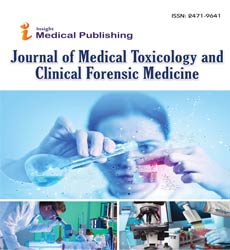Forensic and Clinical Implications of Organophosphate Poisoning: A Comprehensive Review
Caroline Hughes
Department of Medical Toxicology, University of California, San Francisco, USA
Published Date: 2025-02-28DOI10.36648/ 2471-641.11.1.156
Received date: February 03, 2025, Manuscript No. ipjmtcm-25-20805; Editor assigned date: February 05, 2025, Pre QC No. ipjmtcm-25-20805 (PQ); Reviewed date: February 17, 2025, QC No. ipjmtcm-25-20805; Revised date: February 22, 2025, Manuscript No. ipjmtcm-25-20805 (R); Published date: February 28, 2025, DOI: 10.36648/ 2471-641.11.1.156.
Citation: Hughes C (2025) Forensic and Clinical Implications of Organophosphate Poisoning: A Comprehensive Review. J Med Toxicol Clin Forensic: Vol.11 No. 1:156.
Introduction
Organophosphate (OP) compounds are widely utilized as pesticides, herbicides, and chemical warfare agents, making them a significant cause of poisoning worldwide. Their accessibility in agricultural communities, coupled with intentional and accidental exposures, has led to an alarming public health concern. Organophosphates act by irreversibly inhibiting acetylcholinesterase (AChE), resulting in an accumulation of acetylcholine at synaptic junctions, leading to overstimulation of cholinergic receptors. From a clinical standpoint, organophosphate poisoning remains a medical emergency with potentially fatal consequences. From a forensic perspective, it is a recurring issue in cases of suicide, homicide, and occupational hazards. This review aims to highlight both the clinical manifestations and forensic dimensions of OP poisoning, emphasizing its diagnostic, therapeutic, and medico-legal relevance. Organophosphates exert their toxic effects primarily through inhibition of AChE, an enzyme responsible for hydrolyzing acetylcholine. This leads to excessive cholinergic stimulation across muscarinic, nicotinic, and central nervous system receptors [1].
Description
Clinically, this manifests as the classic cholinergic toxidrome: Salivation, Lacrimation, Urination, Defecation, Gastrointestinal Upset, and Emesis (SLUDGE). In severe cases, seizures, respiratory paralysis, and cardiovascular collapse may occur. The degree of toxicity depends on the type of compound, route of exposure, and dosage, with lipophilic OPs demonstrating prolonged toxicity due to fat solubility and delayed release. he clinical picture of OP poisoning varies from acute, subacute, to chronic presentations. Acute exposure is most dramatic, often progressing within minutes to hours. Key diagnostic features include pinpoint pupils (miosis), bradycardia, fasciculations, bronchospasm, and respiratory distress [2]. Subacute manifestations may include neuropathies and psychiatric disturbances, while chronic exposure has been linked to neurobehavioral changes and endocrine disruption. Diagnosis is supported by measuring plasma butyrylcholinesterase or erythrocyte AChE activity, although these tests may not always be available in resource-limited settings. Clinical suspicion remains the cornerstone of diagnosis, especially in endemic agricultural regions [3].
Prompt recognition and intervention are critical in OP poisoning. Immediate priorities include airway management, decontamination, and antidotal therapy. Atropine, a muscarinic antagonist, is the mainstay of treatment, alleviating bronchorrhea, bronchospasm, and bradycardia. Oximes such as pralidoxime (2-PAM) reactivate AChE if administered early, before the â??agingâ?ÂÃÂ process renders the enzyme-inhibitor complex irreversible. Supportive care, including oxygenation, mechanical ventilation, and seizure control, is often necessary. The effectiveness of treatment hinges on rapid diagnosis, adequate dosing, and continuous monitoring [4].
Despite timely intervention, organophosphate poisoning is associated with multiple complications. Intermediate syndrome, occurring 24â??96 hours post-exposure, is characterized by proximal muscle weakness and respiratory insufficiency. Delayed neuropathy may appear weeks later, leading to axonal degeneration and persistent disability. Mortality rates vary depending on access to medical care, with developing nations reporting higher case fatality. Survivors may experience long-term sequelae, including cognitive impairment, chronic fatigue, and psychiatric disturbances, further complicating prognosis. Organophosphates are frequently implicated in suicidal poisoning, particularly in agricultural regions of Asia, Africa, and Latin America. Their ready availability and rapid onset of symptoms make them a common choice for self-harm. These dimensions necessitate robust medico-legal investigation to distinguish between intentional and unintentional exposures [5].
Conclusion
Organophosphate poisoning represents a critical intersection of clinical emergency medicine and forensic toxicology. Its diverse manifestations, ranging from acute cholinergic crises to chronic neurobehavioral disorders, underscore the challenges of timely diagnosis and management. From a forensic standpoint, OP poisoning frequently surfaces in suicides, accidents, and occupational exposures, demanding meticulous investigation and toxicological analysis. Addressing this global health problem requires a multidisciplinary approach involving clinicians, forensic experts, policymakers, and public health authorities. Strengthening preventive measures, enhancing diagnostic capabilities, and enforcing stricter regulations will be instrumental in reducing the medical and forensic burden of organophosphate poisoning.
Acknowledgement
None.
Conflict of Interest
None.
References
- Kalayarasan R, Ananthakrishnan N, Kate, V. (2019). Corrosive ingestion. Indian J Crit Care Med23: S282.
Google Scholar Cross Ref Indexed at
- De Lusong, M. A. A, Timbol, A. B. G, & Tuazon, D. J S. (2017). Management of esophageal caustic injury. World J Gastrointest Pharmacol Ther, 8(2: 90.
Google Scholar Cross Ref Indexed at
- Martin-Loeches I, Leone M, Einav S. (2020). Antibiotic prophylaxis in the ICU: To be or not to be administered for patients undergoing procedures?. Intensive Care Med46: 364-367.
Google Scholar Cross Ref Indexed at
- Thabit AK, Crandon JL, Nicolau DP. (2015). Antimicrobial resistance: Impact on clinical and economic outcomes and the need for new antimicrobials. Expert Opin Pharmacother16: 159-177.
Google Scholar Cross Ref Indexed at
- Zargar SA, Kochhar R, Mehta S, Mehta, S. K. (1991). The role of fiberoptic endoscopy in the management of corrosive ingestion and modified endoscopic classification of burns. Gastrointest Endosc37: 165-169.

Open Access Journals
- Aquaculture & Veterinary Science
- Chemistry & Chemical Sciences
- Clinical Sciences
- Engineering
- General Science
- Genetics & Molecular Biology
- Health Care & Nursing
- Immunology & Microbiology
- Materials Science
- Mathematics & Physics
- Medical Sciences
- Neurology & Psychiatry
- Oncology & Cancer Science
- Pharmaceutical Sciences
